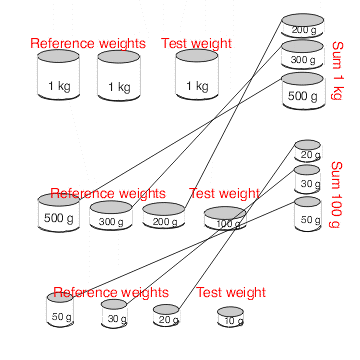2.
Measurement Process Characterization
2.3.
Calibration
2.3.4.
Catalog of calibration designs
|
|
Tie to kilogram reference standards
|
Near-accurate mass measurements require a sequence of designs that
relate the masses of individual weights to a reference kilogram(s)
standard ( Jaeger &
Davis). Weights generally come in sets, and an entire set may
require several series to calibrate all the weights in the set.
|
|
Example of weight set
|
A 5,3,2,1 weight set would have the following weights:
1000 g
500g, 300g, 200g, 100g
50g, 30g 20g, 10g
5g, 3g, 2g, 1g
0.5g, 0.3g, 0.2g, 0.1g
|
|
Depiction of a design with three series for calibrating a
5,3,2,1 weight set with weights between 1 kg and 10 g
|

|
|
First series using 1,1,1,1 design
|
The calibrations start with a comparison of the one kilogram test
weight with the reference kilograms (see the graphic above). The
1,1,1,1 design requires two kilogram
reference standards with known values, \( R_1^* \) and \( R_2^* \).
The fourth kilogram in this design is actually a summation of the
500, 300, 200 g weights which becomes the restraint in the next series.
The restraint for the first series is the known average mass of the
reference kilograms,
$$ R^* = \frac{R_1^* + R_2^*}{2} \, .$$
The design assigns values to all weights including the individual
reference standards. For this design, the check standard is not an
artifact standard but is defined as the difference
between the values assigned to the reference kilograms by the design;
namely,
$$ C = \left( \widehat{R_1^*} - \widehat{R_2^*} \right) \, . $$
|
|
Second series using 5,3,2,1,1,1 design
|
The second series is a 5,3,2,1,1,1 design
where the restraint over the 500g, 300g and 200g weights comes from
the value assigned to the summation in the first series; i.e.,
$$ R^* = \sum 1 = \widehat{X}_{500} + \widehat{X}_{300} + \widehat{X}_{200} \, .$$
The weights assigned values by this series are:
- 500g, 300g, 200 g and 100g test weights
- 100 g check standard (2nd 100g weight in the design)
- Summation of the 50g, 30g, 20g weights.
|
|
Other starting points
|
The calibration sequence can also start with a
1,1,1 design. This design has the
disadvantage that it does not have provision for a check
standard.
|
|
Better choice of design
|
A better choice is a 1,1,1,1,1 design which
allows for two reference kilograms and a kilogram check standard which
occupies the 4th position among the weights. This is preferable to the
1,1,1,1 design but has the disadvantage of requiring the laboratory to
maintain three kilogram standards.
|
|
Important detail
|
The solutions are only applicable for the restraints as shown.
|
|
Designs for decreasing weight sets
|
- 1,1,1 design
- 1,1,1,1 design
- 1,1,1,1,1 design
- 1,1,1,1,1,1 design
- 2,1,1,1 design
- 2,2,1,1,1 design
- 2,2,2,1,1 design
- 5,2,2,1,1,1 design
- 5,2,2,1,1,1,1 design
- 5,3,2,1,1,1 design
- 5,3,2,1,1,1,1 design
- 5,3,2,2,1,1,1 design
- 5,4,4,3,2,2,1,1 design
- 5,5,2,2,1,1,1,1 design
- 5,5,3,2,1,1,1 design
- 1,1,1,1,1,1,1,1 design
- 3,2,1,1,1 design
|
|
Design for pound weights
|
- 1,2,2,1,1 design
|
|
Designs for increasing weight sets
|
- 1,1,1 design
- 1,1,1,1 design
- 5,3,2,1,1 design
- 5,3,2,1,1,1 design
- 5,2,2,1,1,1 design
- 3,2,1,1,1 design
|


